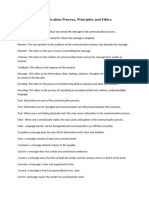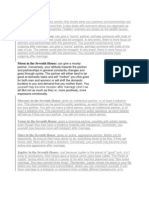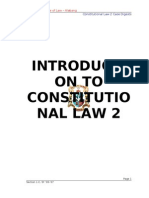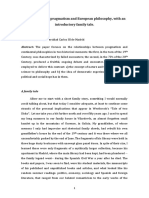Lesson 01: Communication: Process, Principles and Ethics: Outcomes
Uploaded by
Maricris Saturno ManaloLesson 01: Communication: Process, Principles and Ethics: Outcomes
Uploaded by
Maricris Saturno ManaloLesson 01: Communication: Process,
Principles and Ethics
Outcomes:
At the end of the lesson you are expected to:
1. Increase knowledge in communication, its processes and principles hence become
more skillful communicators;
2. Heighten awareness on communication ethics resulting conscientious and
respectful interactions; and
3. Apply the gained knowledge through class exercises.
What is Communication?
Communication is derived from the Latin word “common” which means,
“belonging to many” and “communico” means to confer with others. It is the mutual
exchange of information, ideas, and understanding by any effective means.
Communication is the interaction of words from a society and thus gives pleasure and
an increased understanding of life.
Communication is a human act of sending and receiving of messages where
interpretations are normally constructed in the process.
Holy Cross College Sta. Rosa, N.E. Inc.
What is Purposive Communication?
Purposive communication
- is an intentional communication that happens within the bounds of specific
contexts.
- is a communication applied in a specific setting, environment, scene, social
relations and culture
Contexts affect the process of sending and receiving of messages; semantics or
meanings, choice of channels, words and methods of delivery.
Contexts include:
1. Settings and environment
- Family, school, workplace, religious communities
2. Social Relationship
- Friends, husband and wife, parent child, colleagues/boss-subordinate in the
office
3. Scenes which include place, time, and occasion
- Business meeting, job interview, social gathering parties, weddings, etc.
4. Culture
- History, tradition, beliefs, norms, values
Communication as a Process
https://ecampusontario.pressbooks.pub/communicationatwork/chapter/1-3-the-communication-process/
Communication is a process whereby people create and transmit meaning through
the exchange of verbal and nonverbal messages in a particular context. (Oetzel, 2009:11)
Holy Cross College Sta. Rosa, N.E. Inc.
Communication: The Basic Principles
Elements of Communication
1. SENDER
It is expected that one possesses the skills required in the transmitting messages.
These skills could include the ability to use the language that the receiver understands. For
instance, it will be inept to use the English language if your audience is keener on using their
local language in a Philippine or Asian setting. Along with using the appropriate language is
the application of linguistics features such as correct grammar, phonetics (for spoken
message), choice of words or jargons for an appropriate audience, sentence construction,
and discourse competence.
The sender’s credibility is of great importance as well. People will more likely reject a
message if the sender is proven to be unreliable. The message will only be as good and valid
as its source.
2. DELIVERY
This is an equally important skill that a sender should be able to exhibit properly. In
oral communication, this could include good voice projection, use of appropriate eye
contact, proper articulation of words, and emphasis on important words. Delivery could also
include using appropriate intonation in order to avoid misunderstanding on the part of the
listener/receiver or conflict between the interlocutors. For instance, a high pitch intonation
or an overly emphatic tone might be offensive to listener; hence, the speaker should be
mindful of the manner of delivery.
Holy Cross College Sta. Rosa, N.E. Inc.
3. RECEIVER
Receivers of messages must have good listening and comprehension skills. Good
listening requires one to focus on what is conveyed and as much as possible eliminate all
possible distractions or noises (physical, environmental, psychological, and emotional) that
would hinder one from understanding the message. On the other hand, good
comprehension skills necessitate sharpness of cognition, which can be achieved through
continuous studies and acquisition of information and knowledge.
Receiver must:
Must have good listening and comprehension skills
Eliminate all possible distractions or noises.
Types of noise (physical, environmental, psychological, emotional)
Sharpness of cognition through continuous studies and acquisition of
information and knowledge
4. MESSAGE
For message to be accurately understood and positively received the Cs in
communication maybe followed:
Concise Concrete Complete
Courtesy Clarity
ness ness ness
THE FIVE C’s IN COMUNICATION
1. Courtesy also known as politeness.
Ways to demonstrate courtesy:
using polite words and tone to show respect to the receiver of the message.
applying tact and diplomacy
developing the “WE” attitude using positive words instead of negative
being considerate of the feelings of the receiver
selecting gender-free terms
responding promptly to important messages
Holy Cross College Sta. Rosa, N.E. Inc.
4. Clarity may involve correct word usage, grammar, pronunciation, sentence construction and
delivery. Messages which are unclear oftentimes do not achieve their desired effect.
3. Conciseness lengthy messages can result in information overload and
overwhelm listeners/readers of messages. Conciseness is saying what needs to be said in as few
words as possible. Avoid flowery words.
4. Concreteness this refers to being specific. To demonstrate concreteness, providing
examples whenever necessary makes a message more comprehensible.
5. Completeness To avoid ambiguity, messages should not leave out important
details that a receiver expects to know such as answers to the What, Who, Where, When,
Why and How questions.
5. CHANNELSS
The choice of channel may depend on the availability, practicality, and its impact on the
receiver.
Channels:
Telephone
Radio
Television
Printed texts (books, newspapers, magazines, journals, posters, etc.)
Communication technologies (smart phones, tablets, computers)
6. FEEDBACK
Messages in communication will always have an effect on the receiver. There are
messages that trigger positive reactions and at ties negative depending on the kind of
messages relayed, how it is communicated and how it is interpreted. It is therefore
important to know the feedback of our audience/s (listener/reader) in order to make the
necessary clarifications and revisions of our messages.
Holy Cross College Sta. Rosa, N.E. Inc.
Communication: Barriers and Noise
Experts assert that noise or barriers in communication maybe due to environment,
physical, psychological and emotional conditions. Other than these aspects, differences in
language, gender, and culture can also be barrier in communication.
For communication to be effective, this barriers/noise should be mitigated or if
possible eliminated. Gender and culture differences as communication barriers however can
be more challenging to control and could not be eliminated.
Ethics in Communication
What is Communication Ethics?
Holy Cross College Sta. Rosa, N.E. Inc.
ETHICS a system of moral principles deals with values relating to human conduct,
with respect to the rightness and wrongness of certain actions and to the goodness and
badness of the motives and ends of such actions.
COMMUNICATION ETHICS
The principle governing communication, the right and wrong aspects of it, the moral-
immoral dimensions relevant to Interpersonal communication are called the ethics of
Interpersonal communication.
COMMUNICATION ETHICS
Maintaining the correct balance between the speaking and listening the legitimacy of
fear and emotional appeal degree of criticism and praise
COMMUNICATION ETHICS
A death or an overdose of either of the factors could result in unfavorable
consequences. The principle of honesty on both sides should be completely applied because
any amount of insincerity from either the listener or the speaker would not be prudent.
Regardless of an individual's moral principle (relativistic), ethics in communication
can take a universal approach, which can be displayed in several ways including but not
limited to the following:
1. Adhering to the golden rule or the platinum rule.
The golden rule asserts to always treat others in the same way you want to be treated
while the platinum rule according to Bennett (1980) stresses on trending others the way
they wish to be treated. Ethical communicators address people of other cultures with the
same respect that they would like to receive themselves (Jandt, 2013:37).
2. Considering the feelings of the receiver.
Humans are not only cognitive but also emotional beings. If we are less careful with
or words, tone, and non-verbal gestures, people could be negatively affected. To be ethical in
communicating with others, it will be best to maintain tact and diplomacy in our
communications.
Holy Cross College Sta. Rosa, N.E. Inc.
3. Acknowledging the source of ideas & information.
Sources of ideas and information should be acknowledged appropriately at all times.
It is unethical and unlawful for someone to convey other people's intellectual property
without recognizing the author's names or organizations.
4. Speaking the truth.
This is a universal rule. Unfortunately, there are also those who (for whatever reason)
seem to enjoy propagating falsehood. Take for instance the abundance of fake news or what
others call alternative facts on the Internet. Obviously, this is a violation of communication
ethics and should be stopped by all means.
References and Supplementary Materials
Book Supplementary Reading Materials
Magan, R.G, Nano, M.C.B, Turano, C.T. (2018). Purposive Communication in the 21st
Century.
Intramuros, Manila: Mindshapers Co., Inc.
Holy Cross College Sta. Rosa, N.E. Inc.
Online Supplementary Reading Materials
Bastian, G. (2019). Communication Processes, Principles AND Ethics - GEC 4000.
Retrieved July 10, 2020,
https://www.studocu.com/ph/document/our-lady-of-fatima-university/purposive-
communication/other/communication-processes-principles-and-
ethics/6290396/view
Jaballa, A. (n.d.). LESSON 1 COMMUNICATION Processes Principles and Ethics. Retrieved
July 10, 2020,
https://www.academia.edu/38641612/LESSON_1_COMMUNICATION_Processes_P
rinciples_and_Ethics
Boundless. (n.d.). Boundless Management. Retrieved July 10, 2020, from
https://courses.lumenlearning.com/boundless-management/chapter/barriers-to-
effective-communication/
Holy Cross College Sta. Rosa, N.E. Inc.
You might also like
- Hidden Figures: Context, Analysis and QuestioningNo ratings yetHidden Figures: Context, Analysis and Questioning8 pages
- Communication Processes Principles and EthicsNo ratings yetCommunication Processes Principles and Ethics20 pages
- httpscdn.fbsbx.comvt59.2708-21475653198_1173834334319320_1659114757731484207_n.pdfPRESENTATION-121-1.pdf_nc_cat=101&ccb=No ratings yethttpscdn.fbsbx.comvt59.2708-21475653198_1173834334319320_1659114757731484207_n.pdfPRESENTATION-121-1.pdf_nc_cat=101&ccb=33 pages
- Sultan Kudarat State University: Purposive CommunicationNo ratings yetSultan Kudarat State University: Purposive Communication5 pages
- Lesson 1 Communication Processes, Principles and EthicsNo ratings yetLesson 1 Communication Processes, Principles and Ethics9 pages
- WEEK-2-COMMUNICATION-PRINCIPLES-PROCESSES-AND-ETHICSNo ratings yetWEEK-2-COMMUNICATION-PRINCIPLES-PROCESSES-AND-ETHICS42 pages
- Chapter 1: Communication Processes, Principles and EthicsNo ratings yetChapter 1: Communication Processes, Principles and Ethics73 pages
- MODULE 1 PURPOSSIVE COMMUNICATION MALAYUNING KOMUNIKASYON AutosavedNo ratings yetMODULE 1 PURPOSSIVE COMMUNICATION MALAYUNING KOMUNIKASYON Autosaved27 pages
- Revised-Purposive-Communication-ppt-1 (3)No ratings yetRevised-Purposive-Communication-ppt-1 (3)54 pages
- Chapter 1 Lesson 2 Effective Communication Lecture ModuleNo ratings yetChapter 1 Lesson 2 Effective Communication Lecture Module4 pages
- Purposive Communication Module Unit 1 8No ratings yetPurposive Communication Module Unit 1 869 pages
- Reviewer For The 1ST Summative Examination For English 1No ratings yetReviewer For The 1ST Summative Examination For English 18 pages
- LEARNING-CONTENTS-ON-PURPOSIVE-COMMUNICATIONNo ratings yetLEARNING-CONTENTS-ON-PURPOSIVE-COMMUNICATION116 pages
- Reviewer in Oral Communication 1ST Periodical ExaminationNo ratings yetReviewer in Oral Communication 1ST Periodical Examination5 pages
- Listen, Speak, Lead: Elevate Your Success with Effective CommunicationFrom EverandListen, Speak, Lead: Elevate Your Success with Effective CommunicationNo ratings yet
- Talk with Confidence: A Comprehensive Guide to Effortless Communication with Anyone, Anytime, About AnythingFrom EverandTalk with Confidence: A Comprehensive Guide to Effortless Communication with Anyone, Anytime, About AnythingNo ratings yet
- Ilog Elementary School: Department of Education Region VI-Western VisayasNo ratings yetIlog Elementary School: Department of Education Region VI-Western Visayas6 pages
- Two Tales About Pragmatism and European Philosophy, With An Introductory Family TaleNo ratings yetTwo Tales About Pragmatism and European Philosophy, With An Introductory Family Tale17 pages
- Strategic Management BBA3254 0 Lecture 8 Stakeholders 1No ratings yetStrategic Management BBA3254 0 Lecture 8 Stakeholders 118 pages
- Human Resource Management: Topics To Be CoveredNo ratings yetHuman Resource Management: Topics To Be Covered22 pages
- Bandar Eco-Setia SDN BHD V Angelane Eng - (2No ratings yetBandar Eco-Setia SDN BHD V Angelane Eng - (221 pages
- A Philosophical Analysis of Sexual EthicsNo ratings yetA Philosophical Analysis of Sexual Ethics8 pages
- Adam's Opinion On Justice As Opposed To Humans' in Machines Like Me by Ian McEwanNo ratings yetAdam's Opinion On Justice As Opposed To Humans' in Machines Like Me by Ian McEwan15 pages
- Fisher and Bloomfield Understanding the research processNo ratings yetFisher and Bloomfield Understanding the research process7 pages
- (Ebook) Q&A Employment Law 2003-2004 3ED (Q & A) by Deborah Lockton ISBN 9781859417478, 1859417477pdf download100% (5)(Ebook) Q&A Employment Law 2003-2004 3ED (Q & A) by Deborah Lockton ISBN 9781859417478, 1859417477pdf download53 pages
- httpscdn.fbsbx.comvt59.2708-21475653198_1173834334319320_1659114757731484207_n.pdfPRESENTATION-121-1.pdf_nc_cat=101&ccb=httpscdn.fbsbx.comvt59.2708-21475653198_1173834334319320_1659114757731484207_n.pdfPRESENTATION-121-1.pdf_nc_cat=101&ccb=
- Sultan Kudarat State University: Purposive CommunicationSultan Kudarat State University: Purposive Communication
- Lesson 1 Communication Processes, Principles and EthicsLesson 1 Communication Processes, Principles and Ethics
- WEEK-2-COMMUNICATION-PRINCIPLES-PROCESSES-AND-ETHICSWEEK-2-COMMUNICATION-PRINCIPLES-PROCESSES-AND-ETHICS
- Chapter 1: Communication Processes, Principles and EthicsChapter 1: Communication Processes, Principles and Ethics
- MODULE 1 PURPOSSIVE COMMUNICATION MALAYUNING KOMUNIKASYON AutosavedMODULE 1 PURPOSSIVE COMMUNICATION MALAYUNING KOMUNIKASYON Autosaved
- Chapter 1 Lesson 2 Effective Communication Lecture ModuleChapter 1 Lesson 2 Effective Communication Lecture Module
- Reviewer For The 1ST Summative Examination For English 1Reviewer For The 1ST Summative Examination For English 1
- Reviewer in Oral Communication 1ST Periodical ExaminationReviewer in Oral Communication 1ST Periodical Examination
- Listen, Speak, Lead: Elevate Your Success with Effective CommunicationFrom EverandListen, Speak, Lead: Elevate Your Success with Effective Communication
- Talk with Confidence: A Comprehensive Guide to Effortless Communication with Anyone, Anytime, About AnythingFrom EverandTalk with Confidence: A Comprehensive Guide to Effortless Communication with Anyone, Anytime, About Anything
- Ilog Elementary School: Department of Education Region VI-Western VisayasIlog Elementary School: Department of Education Region VI-Western Visayas
- Two Tales About Pragmatism and European Philosophy, With An Introductory Family TaleTwo Tales About Pragmatism and European Philosophy, With An Introductory Family Tale
- Strategic Management BBA3254 0 Lecture 8 Stakeholders 1Strategic Management BBA3254 0 Lecture 8 Stakeholders 1
- Adam's Opinion On Justice As Opposed To Humans' in Machines Like Me by Ian McEwanAdam's Opinion On Justice As Opposed To Humans' in Machines Like Me by Ian McEwan
- Fisher and Bloomfield Understanding the research processFisher and Bloomfield Understanding the research process
- (Ebook) Q&A Employment Law 2003-2004 3ED (Q & A) by Deborah Lockton ISBN 9781859417478, 1859417477pdf download(Ebook) Q&A Employment Law 2003-2004 3ED (Q & A) by Deborah Lockton ISBN 9781859417478, 1859417477pdf download

























































































